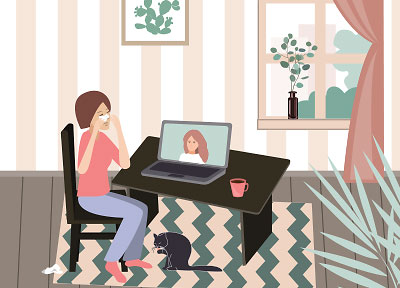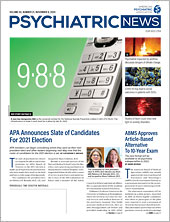Telehealth options for treating patients with substance use disorders (SUDs) are expanding at a time when regulations governing their use have been relaxed in response to the COVID-19 pandemic. Matthew E. Peters, M.D., an assistant professor of psychiatry and behavioral science at Johns Hopkins University School of Medicine, discussed the latest innovations at Johns Hopkins’ annual Road to Recovery conference, a virtual event held in September.
“This is an opportunity for us to make the most of a good thing. A potential silver lining of COVID-19 is that telehealth has made a generational leap forward,” Peters said.
Peters reviewed four different types of telehealth relevant to the treatment of SUDs, beginning with live video conferencing, which includes using platforms such as Doximity, Polycom, Webex, and Zoom.
“One of the key changes that occurred during COVID-19 was the ability to treat patients from their own homes using telehealth. Before that, providers could be anywhere, but patients had to be sitting in a clinical setting,” Peters explained.
The second type of telehealth uses store-and-forward technology for the electronic delivery of a patient’s documented health history outside of real time. The most common form of store-and-forward telehealth is the electronic medical record, which can be used by the patient and physician to send messages back and forth to each other.
Peters highlighted directly observed therapy as a newer form of store-and-forward telehealth. Patients take videos of themselves taking their medications and send the videos to their health professionals, who then view the videos and sign off in the patients’ records that the patients took their medications appropriately. Directly observed therapy was originally used to ensure that patients with tuberculosis took their medications, but it is now catching on for treating patients with SUDs, Peters said. He added that this is partially because the Substance Abuse and Mental Health Services Administration has allowed methadone programs to give up to a 28-day take-home supply of methadone to their patients during the COVID-19 pandemic (see
Psychiatric News).
“You’re able to have a larger volume of take-homes but at the same time you’re able to observe the patient taking the medication, ensure proper administration of the medication, and prevent diversion,” Peters said.
A third type of telehealth is remote patient monitoring, which involves collecting a patient’s health data at one location and transmitting the data electronically to a health professional at another location. Remote patient monitoring has been used for blood pressure monitoring and cardiac rhythm monitoring, but like store-and-forward telehealth, its use in mental health care is growing, Peters said.
“The important part of this is that it has to be remote. It can’t be a patient who is sitting there in a clinic room with you and you’re there entering data,” Peters said. “The patient can be at home or … anywhere other than a one-on-one visit with you having a provider-patient conversation that you are going to bill for.” Peters noted that a company for which he is the chief medical officer, Rose: Smarter Mental Health, offers a platform where, between sessions with health professionals, patients can use an app for reporting on their anxiety, engaging in daily journaling, and taking standardized assessments like the Generalized Anxiety Disorder-7 scale. Health professionals log in to look at the data and respond to the patients with simple interactions like sending the patients new content to read, providing feedback on the patients’ assessments, or offering encouragement.
Peters said that remote patient monitoring may play a role in spotting early indicators of problematic prescription opioid use, such as worsening depression or anxiety, sleep problems, or increasing pain scores in patients who are prescribed opioids.
“The medical team can intervene in between visits if concerning symptoms develop,” Peters said. He added that remote patient monitoring has its own set of CPT codes. “Although you have to check with the insurance companies, this may be a reimbursable activity on top of the revenue you receive for in-person visits.”
Mobile health is the fourth and broadest category of telehealth and includes the use of smart devices and health-based software apps to support health care and encourage healthier lifestyle behaviors. The apps may include self-help content, peer support, or meditation or mindfulness sessions.
“This is a huge market, with over 10,000 platforms just in the mental health space alone. However, very few of them are evidence based,” Peters said.
Peters highlighted a company affiliated with Johns Hopkins called Marigold Health, which offers online peer support via group texts. This allows patients to participate in a recovery community that is different from the regular groups in a clinic setting.
“This has been very helpful for patients during COVID-19, when a lot of the standard in-person groups were closed down,” Peters said. He explained that the platform uses natural language processing, a form of artificial intelligence, to monitor the text that patients enter and ensure that their conversations are appropriate. “It allows larger groups to participate while still providing some oversight.”
Overall, Peters said that he is optimistic about the use of telehealth for treating patients with SUDs, but that it is necessary to acquire evidence of its effectiveness.
“It looks very positive that this is a way to increase access to care and to be flexible and deliver care in a safe way,” Peters said. “[But] once we’re all able to take a breath from what we’re going through right now [with the pandemic], time does need to be taken to make sure we are doing the right thing by our patients.” ■
APA, in conjunction with the American Telehealth Association, has released “Best Practices in Videoconferencing-Based Telemental Health,” a guide for mental health professionals who would like to offer their patients telemental health, including telepsychiatry. It is posted
here.


